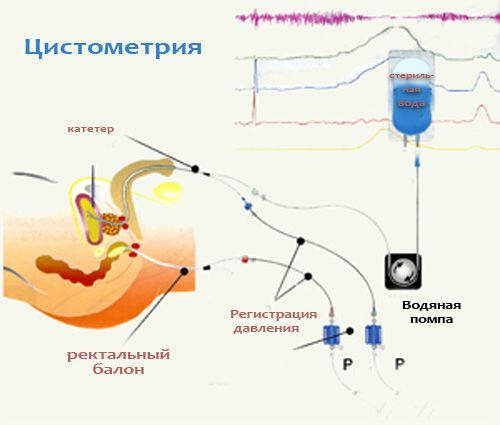Most diagnostic methods used in urology, helps to assess, as a rule, only major changes in the urogenital system (e.g., ultrasound, CT scans, etc.).
However, there are many clinical cases where the diagnosis results demonstrate the absence of pathology, and the patient remains without treatment.
In such cases it is advisable to use functional methods of diagnostics, among which the urodynamic study of the bladder. The research presents a complex diagnostic procedures, during which the monitoring of the functional state of the organ, its evacuation and cumulative functions.
Who is a urodynamic study?
Urodynamics is the process of excretion of urine through the coordinated work of the urinary organs. So, if you have problems with urination for an accurate diagnosis and selecting therapy should undergo a urodynamic study of the bladder.
The study has a number of indications:
- Urinary incontinence of various origins.
- Polyuria or dysuria.
- Difficulties when urinating.
- Pain and cramps in the lower abdomen.
- The absence or weakening of the feeling of fullness of the bladder.
- Chronic diseases that are not amenable to standard therapy (chronic cystitis, pyelonephritis, prostatitis, etc.).
Pyelonephritis is a condition that requires the undertaking of several studies of urodynamics

So, cause of problems with urination can be a urinary tract obstruction, worsening of contractility of the walls of the bladder or neurogenic disorders, innervation of the bladder (sphincter-derosnay dyssynergia, Hypo-and hyperactivity of the detrusor) and many more.
What reveal the study?
Estimated sensitivity of the bladder, Hyper – or hypoactive detrusor, the amount of residual urine. Estimated urethral competence during filling-bladder, investigates the function of the detrusor during urination.
Additionally can be estimated urethral resistance, ENMG of the pelvic floor muscles. We study the correlation between subjective sensations of the patient and the results of urodynamic studies.
What’s included in the UDI?
The research program is determined by a physician. Takes into account clinical and anamnestic data, individual characteristics, General condition of the patient.
Urinalysis
Laboratory tests reveal the presence of inflammatory process, its course, to determine the pathogen and also indirectly indicate some diseases.
Cystometry
Method of study condition the reservoir for urine.

Diagnosis is carried out as follows:
- The introduction of a catheter through the urethra.
- The attachment of electrodes for EMG.
- Injection of saline through the channel.
- Tracking the functional state of the bladder, fixation of changes during filling with liquid.
- Researched reports on the sensations and intensity of the impulses, is also fixed.
- The patient urinates into a device that allows you to follow the contraction of the bladder.
Cystometry is one of the most indicative methods of diagnosis
According to the study, the doctor can detect the work discoordination of the bladder and sphincters.
Cystoscopy
Endoscopic procedure performed with the aid of a cystoscope, which allows you to see the inner (mucosa) of the bladder wall. Such a study is carried out under anesthesia.
Uroflowmetry
With the help of a special apparatus, uroflowmetry, determines the rate of urine flow during urination, as well as the exact amount of urine and the duration of mocheispuskaniya. During the study, the patient urinates into the funnel of the device, which determines the above parameters of the process of urination. Data are broadcast on a computer monitor in graph form.
Profilometry
Allows to determine the pressure required to retain the urine. Into the bladder introduced a special catheter. Built-in sensor to register the pressure on during extraction of the catheter from the urethral channel. Also conducted provocative tests. The method allows to establish the cause of incontinence and other disorders.
Study of residual urine volume
Diagnosis is performed under the control of ULTRASONIC research. After urinating, the bladder catheter can measure residual urine volume.
ULTRASONIC examination of the
Investigates the structural condition of the bladder in combination with other research methods.
The procedure requires proper preparation of the patient to the study
Stress test
Patient enough to cough with a full bladder. The method used in the diagnosis of urinary incontinence. Often patients put off visiting a urologist, afraid to talk about my delicate problem because of excessive shyness.
Nevertheless, it is crucial to identify the problem and start solving it before it affected the General health and did not pose a threat to life. Most procedures are completely painless, but some can deliver some discomfort.





Thanks for your post. I would love to say that a health insurance specialist also utilizes the benefit of the actual coordinators of a group insurance. The health insurance broker is given an index of benefits sought by individuals or a group coordinator. Such a broker really does is hunt for individuals or coordinators which will best fit those requirements. Then he shows his ideas and if each party agree, this broker formulates a legal contract between the two parties.
One other thing I would like to mention is that in lieu of trying to fit all your online degree lessons on days of the week that you conclude work (as most people are drained when they come home), try to find most of your sessions on the weekends and only a few courses for weekdays, even if it means taking some time away from your end of the week. This is fantastic because on the week-ends, you will be far more rested and concentrated upon school work. Thanks alot : ) for the different points I have mastered from your site.